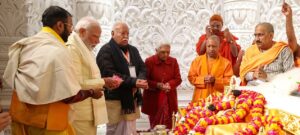
Creating a New Story: Controversial Hindu Temple Inaugurated in India
With a grand ceremony, Indian Prime Minister Modi inaugurated a new Hindu temple. The building, however, is surrounded by controversy as it was constructed on the ruins of a mosque. The opposition criticized it as a display of power.
A Hindu priest blew a traditional conch shell horn to consecrate the new Ram temple in Ayodhya, the holy city in the northern Indian state of Uttar Pradesh. And Indian Prime Minister Narendra Modi chose dramatic words to describe what was happening after the ceremony.
“Today is January 22, 2024. Not just any date on the calendar, but the beginning of a new era,” said Narendra Modi. Today, “after centuries of patience, countless sacrifices, and penance,” Lord Ram has returned to his birthplace.
Billion-dollar Infrastructure Project
Modi fulfilled a decades-old promise that a temple for one of Hinduism’s central deities would be built at this very spot. Modi said, “Today, we have freed ourselves from the mindset of slavery and embraced a complicated past.” He added, “The future, however, looks bright from now on. We are creating a new story.”
It is a new story that Modi’s government is investing around 200 million euros in. It includes not just the temple and temple complex but also a billion-dollar infrastructure project to transform the entire Ayodhya into a shining city.
Mosque Destroyed in 1992
The temple itself is highly controversial as it practically stands on the ruins of a mosque. The mosque was destroyed by Hindu fanatics in 1992, leading to subsequent riots that claimed 2,000 lives. Journalist Nilanjan Mukhopadhyay, who has written a book about Ayodhya, says the events of 1992 still hold great significance.
“The events of 1992 are still of great importance today,” the journalist said. Those who were present in Ayodhya on December 6, 1992, to destroy the mosque, will now come to participate in a kind of victory celebration and a victory parade.
Modi Did Not Directly Address the Conflict
However, critical voices are barely heard on this day. It is a celebration for Ayodhya, India, and Hindus worldwide. Prime Minister Modi appeared as the high priest, leading the consecration ceremony in the inner sanctum of the temple, dressed in a traditional golden Kurta. Surrounding him were Hindu priests singing religious songs.
Everything was broadcasted on a giant screen outside, where thousands of guests were seated. Among them were politicians, priests, actors, and industrialists. Additionally, hundreds of millions of people across India watched the event live on television and the internet.
Prime Minister Modi indirectly addressed the conflicts surrounding Ayodhya, and most people understood him. “Some may say that the construction of the Ram temple will ignite a firestorm,” he said. “Today, I want to urge those people to reconsider. Because Ram is energy, not fire. Ram is the solution, not conflict.”
Opposition Boycotts the Ceremony
Nevertheless, Modi’s opponents accuse him of merging politics and religion to an unprecedented extent with the temple inauguration, especially since parliamentary elections are approaching in India this spring.
Critics claim that Modi wants to transform the country into a Hindu state. This is further evidenced by the fact that, for the first time at a government-led event like this, the leader of the Hindu cadre organization RSS was allowed to speak. The RSS has been criticized for its fascist tendencies.
On the other hand, opposition leaders stayed away from the temple consecration. They did not want to retroactively legitimize past injustices and did not want to be part of an event that they deemed to be a demonstration of power by the ruling Hindu nationalists.